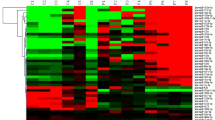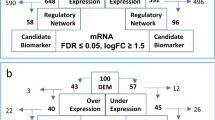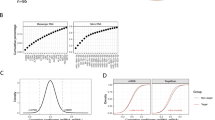Abstract
Distinct microRNA (miRNA) and mRNA signatures were reported in nucleophosmin (NPM1)-mutated acute myeloid leukemia (AML). However, it remains unknown whether the mutation participates in the dynamic interaction between miRNA and mRNA. In this study, we aimed to investigate the role of NPM1 mutation in modulating miRNA–mRNA regulation (MMR). From the sample-paired miRNA/mRNA microarrays of 181 de novo AML patients, we found that MMR was dynamic and could be affected by NPM1 mutation. By a systematic framework, we identified 493 NPM1 mutation-modulated MMR pairs, where the strength of MMR was significantly attenuated in patients carrying NPM1 mutations, compared to those with wild-type NPM1. These miRNAs/mRNAs were associated with pathways implicated in cancer and known functions of NPM1 mutation. Such modulation of MMR was validated in two independent cohorts as well as in cells with different NPM1 mutant burdens. Furthermore, we showed that the regulatory strength of nine MMR pairs could predict patients’ outcomes. Combining these pairs, a scoring system was proposed and shown to predict survival in discovery and validation data sets, independent of other known prognostic factors. Our study provides novel biological insights into the role of NPM1 mutation as a modulator of MMR, based on which a novel prognostic marker is proposed in AML.
This is a preview of subscription content, access via your institution
Access options
Subscribe to this journal
Receive 12 print issues and online access
$259.00 per year
only $21.58 per issue
Buy this article
- Purchase on Springer Link
- Instant access to full article PDF
Prices may be subject to local taxes which are calculated during checkout






Similar content being viewed by others
Accession codes
References
Renneville A, Roumier C, Biggio V, Nibourel O, Boissel N, Fenaux P et al. Cooperating gene mutations in acute myeloid leukemia: a review of the literature. Leukemia 2008; 22: 915–931.
Dohner K, Schlenk RF, Habdank M, Scholl C, Rucker FG, Corbacioglu A et al. Mutant nucleophosmin (NPM1) predicts favorable prognosis in younger adults with acute myeloid leukemia and normal cytogenetics: interaction with other gene mutations. Blood 2005; 106: 3740–3746.
Verhaak RG, Goudswaard CS, van Putten W, Bijl MA, Sanders MA, Hugens W et al. Mutations in nucleophosmin (NPM1) in acute myeloid leukemia (AML): association with other gene abnormalities and previously established gene expression signatures and their favorable prognostic significance. Blood 2005; 106: 3747–3754.
Thiede C, Koch S, Creutzig E, Steudel C, Illmer T, Schaich M et al. Prevalence and prognostic impact of NPM1 mutations in 1485 adult patients with acute myeloid leukemia (AML). Blood 2006; 107: 4011–4020.
Alcalay M, Tiacci E, Bergomas R, Bigerna B, Venturini E, Minardi SP et al. Acute myeloid leukemia bearing cytoplasmic nucleophosmin (NPMc+AML) shows a distinct gene expression profile characterized by up-regulation of genes involved in stem-cell maintenance. Blood 2005; 106: 899–902.
Garzon R, Garofalo M, Martelli MP, Briesewitz R, Wang L, Fernandez-Cymering C et al. Distinctive microRNA signature of acute myeloid leukemia bearing cytoplasmic mutated nucleophosmin. Proc Natl Acad Sci U S A 2008; 105: 3945–3950.
Becker H, Marcucci G, Maharry K, Radmacher MD, Mrozek K, Margeson D et al. Favorable prognostic impact of NPM1 mutations in older patients with cytogenetically normal de novo acute myeloid leukemia and associated gene- and microRNA-expression signatures: a Cancer and Leukemia Group B study. J Clin Oncol 2010; 28: 596–604.
Russ AC, Sander S, Luck SC, Lang KM, Bauer M, Rucker FG et al. Integrative nucleophosmin mutation-associated microRNA and gene expression pattern analysis identifies novel microRNA - target gene interactions in acute myeloid leukemia. Haematologica 2011; 96: 1783–1791.
Lewis BP, Burge CB, Bartel DP . Conserved seed pairing, often flanked by adenosines, indicates that thousands of human genes are microRNA targets. Cell 2005; 120: 15–20.
Yendamuri S, Calin GA . The role of microRNA in human leukemia: a review. Leukemia 2009; 23: 1257–1263.
Chuang MK, Chiu YC, Chou WC, Hou HA, Chuang EY, Tien HF . A 3-microRNA scoring system for prognostication in de novo acute myeloid leukemia patients. Leukemia 2015; 29: 1051–1059.
Ideker T, Krogan NJ . Differential network biology. Mol Syst Biol 2012; 8: 565.
Ben-Hamo R, Efroni S . MicroRNA-gene association as a prognostic biomarker in cancer exposes disease mechanisms. PLoS Comput Biol 2013; 9: e1003351.
Cancer Genome Atlas Research Network. Genomic and epigenomic landscapes of adult de novo acute myeloid leukemia. New Engl J Med 2013; 368: 2059–2074.
Papadopoulos GL, Reczko M, Simossis VA, Sethupathy P, Hatzigeorgiou AG . The database of experimentally supported targets: a functional update of TarBase. Nucleic Acids Res 2009; 37: D155–D158.
Xiao F, Zuo Z, Cai G, Kang S, Gao X, Li T . miRecords: an integrated resource for microRNA-target interactions. Nucleic Acids Res 2009; 37: D105–D110.
Friedman RC, Farh KK, Burge CB, Bartel DP . Most mammalian mRNAs are conserved targets of microRNAs. Genome Res 2009; 19: 92–105.
Krek A, Grun D, Poy M, Wolf R, Rosenberg L, Epstein E et al. Combinatorial microRNA target predictions. Nat Genet 2005; 37: 495–500.
Maragkakis M, Alexiou P, Papadopoulos GL, Reczko M, Dalamagas T, Giannopoulos G et al. Accurate microRNA target prediction correlates with protein repression levels. BMC Bioinformatics 2009; 10: 295.
Maragkakis M, Reczko M, Simossis VA, Alexiou P, Papadopoulos GL, Dalamagas T et al. DIANA-microT web server: elucidating microRNA functions through target prediction. Nucleic Acids Res 2009; 37: W273–W276.
Lu TP, Lee CY, Tsai MH, Chiu YC, Hsiao CK, Lai LC et al. miRSystem: an integrated system for characterizing enriched functions and pathways of microRNA targets. PLoS One 2012; 7: e42390.
Subramanian A, Tamayo P, Mootha VK, Mukherjee S, Ebert BL, Gillette MA et al. Gene set enrichment analysis: a knowledge-based approach for interpreting genome-wide expression profiles. Proc Natl Acad Sci USA 2005; 102: 15545–15550.
Chiu Y-C, Wu C-T, Hsiao T-H, Lai Y-P, Hsiao C, Chen Y et al. Co-modulation analysis of gene regulation in breast cancer reveals complex interplay between ESR1 and ERBB2 genes. BMC Genomics 2015; 16 (Suppl 7): S19.
Mouw JK, Yui Y, Damiano L, Bainer RO, Lakins JN, Acerbi I et al. Tissue mechanics modulate microRNA-dependent PTEN expression to regulate malignant progression. Nat Med 2014; 20: 360–367.
Goodwin PJ, Ennis M, Pritchard KI, Trudeau ME, Koo J, Taylor SK et al. Insulin- and obesity-related variables in early-stage breast cancer: correlations and time course of prognostic associations. J Clin Oncol 2012; 30: 164–171.
Quentmeier H, Martelli MP, Dirks WG, Bolli N, Liso A, Macleod RA et al. Cell line OCI/AML3 bears exon-12 NPM gene mutation-A and cytoplasmic expression of nucleophosmin. Leukemia 2005; 19: 1760–1767.
Lozzio CB, Lozzio BB . Human chronic myelogenous leukemia cell-line with positive Philadelphia chromosome. Blood 1975; 45: 321–334.
Chou WC, Jie C, Kenedy AA, Jones RJ, Trush MA, Dang CV . Role of NADPH oxidase in arsenic-induced reactive oxygen species formation and cytotoxicity in myeloid leukemia cells. Proc Natl Acad Sci USA 2004; 101: 4578–4583.
Smoot ME, Ono K, Ruscheinski J, Wang PL, Ideker T . Cytoscape 2.8: new features for data integration and network visualization. Bioinformatics 2011; 27: 431–432.
Burnett A, Wetzler M, Lowenberg B . Therapeutic advances in acute myeloid leukemia. J Clin Oncol 2011; 29: 487–494.
Chou WC, Chou SC, Liu CY, Chen CY, Hou HA, Kuo YY et al. TET2 mutation is an unfavorable prognostic factor in acute myeloid leukemia patients with intermediate-risk cytogenetics. Blood 2011; 118: 3803–3810.
Tili E, Michaille JJ, Luo Z, Volinia S, Rassenti LZ, Kipps TJ et al. The down-regulation of miR-125b in chronic lymphocytic leukemias leads to metabolic adaptation of cells to a transformed state. Blood 2012; 120: 2631–2638.
Oevermann L, Scheitz J, Starke K, Kock K, Kiefer T, Dolken G et al. Hematopoietic stem cell differentiation affects expression and function of MRP4 (ABCC4), a transport protein for signaling molecules and drugs. Int J Cancer 2009; 124: 2303–2311.
Copsel S, Garcia C, Diez F, Vermeulem M, Baldi A, Bianciotti LG et al. Multidrug resistance protein 4 (MRP4/ABCC4) regulates cAMP cellular levels and controls human leukemia cell proliferation and differentiation. J Biol Chem 2011; 286: 6979–6988.
Ansari M, Sauty G, Labuda M, Gagne V, Laverdiere C, Moghrabi A et al. Polymorphisms in multidrug resistance-associated protein gene 4 is associated with outcome in childhood acute lymphoblastic leukemia. Blood 2009; 114: 1383–1386.
Du Y, Spence SE, Jenkins NA, Copeland NG . Cooperating cancer-gene identification through oncogenic-retrovirus-induced insertional mutagenesis. Blood 2005; 106: 2498–2505.
Krivtsov AV, Twomey D, Feng Z, Stubbs MC, Wang Y, Faber J et al. Transformation from committed progenitor to leukaemia stem cell initiated by MLL-AF9. Nature 2006; 442: 818–822.
Diaz-Beya M, Brunet S, Nomdedeu J, Tejero R, Diaz T, Pratcorona M et al. MicroRNA expression at diagnosis adds relevant prognostic information to molecular categorization in patients with intermediate-risk cytogenetic acute myeloid leukemia. Leukemia 2014; 28: 804–812.
Marcucci G, Yan P, Maharry K, Frankhouser D, Nicolet D, Metzeler KH et al. Epigenetics meets genetics in acute myeloid leukemia: clinical impact of a novel seven-gene score. J Clin Oncol 2014; 32: 548–556.
Falini B, Mecucci C, Tiacci E, Alcalay M, Rosati R, Pasqualucci L et al. Cytoplasmic nucleophosmin in acute myelogenous leukemia with a normal karyotype. New Engl J Med 2005; 352: 254–266.
Salmena L, Poliseno L, Tay Y, Kats L, Pandolfi PP . A ceRNA hypothesis: the Rosetta Stone of a hidden RNA language? Cell 2011; 146: 353–358.
Tay Y, Kats L, Salmena L, Weiss D, Tan SM, Ala U et al. Coding-independent regulation of the tumor suppressor PTEN by competing endogenous mRNAs. Cell 2011; 147: 344–357.
Karreth FA, Tay Y, Perna D, Ala U, Tan SM, Rust AG et al. In vivo identification of tumor- suppressive PTEN ceRNAs in an oncogenic BRAF-induced mouse model of melanoma. Cell 2011; 147: 382–395.
Sumazin P, Yang X, Chiu HS, Chung WJ, Iyer A, Llobet-Navas D et al. An extensive microRNA-mediated network of RNA-RNA interactions regulates established oncogenic pathways in glioblastoma. Cell 2011; 147: 370–381.
Ala U, Karreth FA, Bosia C, Pagnani A, Taulli R, Leopold V et al. Integrated transcriptional and competitive endogenous RNA networks are cross-regulated in permissive molecular environments. Proc Natl Acad Sci USA 2013; 110: 7154–7159.
Chiu Y-C, Chuang EY, Hsiao T-H, Chen Y . Modeling competing endogenous RNA regulatory networks in glioblastoma multiforme. Bioinformatics and Biomedicine (BIBM), 2013 IEEE International Conference on 18–21 December 2013; pp. 201–204.
Dumbar TS, Gentry GA, Olson MO . Interaction of nucleolar phosphoprotein B23 with nucleic acids. Biochemistry 1989; 28: 9495–9501.
Wang K, Zhang S, Weber J, Baxter D, Galas DJ . Export of microRNAs and microRNA-protective protein by mammalian cells. Nucleic Acids Res 2010; 38: 7248–7259.
Taylor IW, Linding R, Warde-Farley D, Liu Y, Pesquita C, Faria D et al. Dynamic modularity in protein interaction networks predicts breast cancer outcome. Nat Biotechnol 2009; 27: 199–204.
Acknowledgements
The study was supported by a National Taiwan University Hospital−National Taiwan University joint research grant (UN103-051), Ministry of Science and Technology of Taiwan (MOST102-2325-B-002-028, 103-2314-B-002-130-MY3, 103-2314-B-002-131-MY3, 103-2314-B-002-034-MY3, 103-2320-B-002-065-MY3, 104-2311-B-002-030 and 104-2923-B-002-001), and Ministry of Health and Welfare of Taiwan (MOHW102-TD-C-111-001 and MOHW103-TD-B-111-04). We thank the NTU Center of Genomic Medicine, National Taiwan University, for providing financial support (104R8400) and computing facilities. We also thank Mark D Minden, MD PhD, from Princess Margaret Hospital, Toronto, Canada, for kindly providing the OCI/AML3 cell line and Melissa Stauffer, PhD, of Scientific Editing Solutions, for editing the manuscript.
Author contributions
YCC, MHT, WCC, HFT and EYC conceived the study together. WCC, HAH and HFT prepared and provided the NTUH data sets. YCC designed the analysis framework, collected the TCGA data sets and carried out the data analyses. YCC, MHT, WCC, YCL, YYK and EYC designed, and YCL and YYK performed the in vitro experiments. YCC, MHT, WCC, YCL and EYC participated in data interpretation. TPL, LCL and YC contributed important materials and help to the study. YCC drafted the manuscript. MHT, WCC, HFT and EYC revised the manuscript. All authors read and approved the final manuscript.
Author information
Authors and Affiliations
Corresponding authors
Ethics declarations
Competing interests
The authors declare no conflict of interest.
Additional information
Supplementary Information accompanies this paper on the Leukemia website
Supplementary information
Rights and permissions
About this article
Cite this article
Chiu, YC., Tsai, MH., Chou, WC. et al. Prognostic significance of NPM1 mutation-modulated microRNA−mRNA regulation in acute myeloid leukemia. Leukemia 30, 274–284 (2016). https://doi.org/10.1038/leu.2015.253
Received:
Revised:
Accepted:
Published:
Issue Date:
DOI: https://doi.org/10.1038/leu.2015.253
This article is cited by
-
Distinct clinical and biological characteristics of acute myeloid leukemia with higher expression of long noncoding RNA KIAA0125
Annals of Hematology (2021)
-
Development and validation of GMI signature based random survival forest prognosis model to predict clinical outcome in acute myeloid leukemia
BMC Medical Genomics (2019)
-
Multifunctional Gold Nanoparticles Overcome MicroRNA Regulatory Network Mediated-Multidrug Resistant Leukemia
Scientific Reports (2019)
-
Long non-coding RNA HOXB-AS3 promotes myeloid cell proliferation and its higher expression is an adverse prognostic marker in patients with acute myeloid leukemia and myelodysplastic syndrome
BMC Cancer (2019)
-
The distinct biological implications of Asxl1 mutation and its roles in leukemogenesis revealed by a knock-in mouse model
Journal of Hematology & Oncology (2017)



